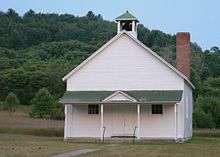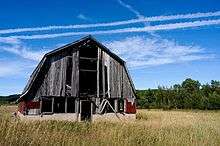Port Oneida Rural Historic District
Port Oneida Rural Historic District is part of the Sleeping Bear Dunes National Lakeshore. It consists of a set of farms in the Leelanau Peninsula of Northern Michigan that are typical of Northern European settlers throughout the Midwestern United States in the later part of the 19th century.[1][2]
Port Oneida Rural Historic District | |
 Sign for the district | |
  | |
| Location | Leelanau Peninsula, Michigan |
|---|---|
| Coordinates | 44°54′47″N 86°01′13″W |
| Area | Northern Michigan |
| Built | mid-1800s to mid-1900s |
| NRHP reference No. | 97000563 |
| Added to NRHP | June 1, 1997 |
The district was farmed for over 100 years by local farmers of subsistence farms. The houses and fields were passed down through the families.[1] What is represented in the district is the practice of land use, architecture and the evolution of agricultural technology common to the upper Great Lakes region.[1] It is very rare to find such a large collection of farms of this time period that are free from modern technology.[1][2]
Port Oneida Rural Historic District has 121 buildings, 20 structures and 18 farmsteads.[3][4] The district is over 3,400 acres (1,400 ha) of farming area preserved as it was in the late 19th century to the mid-20th century.[5] It is the largest historic agricultural community in the United States under government ownership that is fully protected by the government.[2][6][7][8]
The district has the greatest number of historic buildings and has the largest agricultural area.[2] It is on the National Register of Historic Places as of June, 1997.[5] It has a "State" level of significance on the National Register.[2]
History
The Leelanau Peninsula was occupied sometime soon after the Ice age glaciers’ last retreat. Inhabitants were initially drawn to northern Michigan because of the fisheries and forests. Agriculture soon developed since there was longer growing seasons. Lake Michigan provided a lake effect warmth along the shoreline in this area.[9] Cree and Ojibwa were among the Native Americans who lived in the area for generations. The first European recorded in this region was Carsten Burfiend.[9] He was an immigrant from Hanover, Germany in 1846. He arrived in the United States at Buffalo, New York and first went by steamship to nearby North Manitou Island. He came to the peninsula alone and left his wife and family in New York state. Burfiend built a cabin there and worked as a fisherman until 1852. The U.S. Government around this time opened up the mainland of Michigan Territory to settlement. Burfriend moved and purchased 275 acres (111 ha) of land on the west side of Pyramid Point. He then sent for his wife and children.[9]
Burfiend continued to work as a fisherman on mainland Michigan with his fishing boat. Also using his boat he would ferry early settlers between South Manitou Island and North Manitou Island from the mainland of Michigan. History records that John E. Fisher was one of his passengers going to the islands. Fisher was one of the first settlers on the mainland of northern Michigan and a founder of Glen Arbor, Michigan. Burfiend and his family lived in a three-story log cabin on the beach. Ultimately Lake Michigan's fierce storms forced them to move their home to the Sleeping Bear Dunes bluffs above the lake. Because of the harsh environment of the early days, Burfiend lost three of his sons to pneumonia and drowning.[9]
Frederick and Margaretta Werner of Hanover, Germany, were close friends and possibly related to the Burfiends. They joined the Burfiends in September 1855 and settled in the area. Several other settlers came from Hanover.[9] The 1860 census shows the population of Pyramid Point to be 87 people. They were immigrants from Germany and Prussia.[9]

Thomas Kelderhouse was a key person to Port Oneida. He developed most of the Port Oneida logging industry. Kelderhouse was born in Albany, New York in 1821.[9] His cargo ships traveled throughout Lake Michigan. Kelderhouse is recorded on one of his trips to have landed on South Manitou Island. He reportedly saw the mainland economic opportunities of the Michigan dense forests of white pine. He negotiated with Burfiend and they agreed on building a dock on the shore of Lake Michigan if Burfiend provided the land. In 1862 the dock was completed. Port Oneida is named after the steamship Oneida, one of the first to stop at Burfiend's new dock.[9]
The dock allowed the mainland's hardwood forest to be harvested. Kelderhouse bought land and began processing cordwood to sell to passing ships for firewood. He built a sawmill near the John Burfiend farm. Port Oneida grew considerably over the next 30 years to include many commercial enterprises. Among these were a general store, a post office, a blacksmith shop and a boarding house. There were also two large barns built by other farmers. Kelderhouse owned most of the commercial buildings at Port Oneida and about half of the land on Pyramid Point. He built his home at Port Oneida. Kelderhouse also bought a gristmill on the Crystal River from John Fisher in 1866 to process grains.[9]
Between 1880 and 1890, the lumber industry, however, had taken most of the timber. The Great Lakes steamships by then were burning coal instead of firewood. Due to competition, such as the D.H. Day farm in Glen Haven, Kelderhouse sold off the dock and mill by 1880. He died in 1884 which led to the demise of the family fortune.[9]
All the original buildings at Port Oneida were abandoned by 1908. Only the Kelderhouse residence was still occupied by his family. In 1934 it was then sold to Fred Baker. The boarding house at Port Oneida was torn down in 1944. Other buildings and the apple orchard were removed by 1952. Wood of these buildings had been used to build the Burfiend pig barn and the Barratt barn.[9]
Port Oneida area farming was difficult and harsh. The sandy soils did not produce much. Water was limited, which hindered their efforts. Potatoes were their primary cash crop. Their limited supply of grain sustained small herds of dairy cattle. Most employed themselves outside their farms to make ends meet.[9]
Port Oneida was a close-knit ordinary farming community from the turn of the 20th century until World War II. Farmers worked together by going from farm to farm to gather and harvest seasonal crops.[9]
Farm buildings description

A typical farmhouse of the area was generally of two stories with the bedrooms upstairs.[10] A Michigan Basement with thick stone walls can still be found at some of these farmhouses. They were used for storing canned goods. Later years furnaces and water heaters were put in the basement instead.[10] Typical outhouses that were associated with the farmhouses can be found at the Thoreson and Dechow farms.[10]
There are several barns still existing in the district. The typical barn of the area had two stories and was used for cows and calves, especially in the winter months.[10] Corn cribs can be found at the Bufka, Burfiend, Dechow, Eitzen, and Thoreson farms.[10] A granary can still be found at the Thoreson, Dechow, and Bufka farms.[10] A sugar house or sugar shack is at the Oechow farm on M22. A silo can be found at the Olsen farm on M22.[10] A cement stave silo is located at the Dechow farm and a tile silo is at the Eitzen farm.[10] A milk house or spring house can be found at the Dechow farm and at the Thoreson Farm. Chicken coops are still found at Dechow, Thoreson and the Lawr farms.[10]
Port Oneida Fair
The Port Oneida Fair takes place once a year on the second Friday and Saturday of August.[11][12][13] It displays crafts and skills by representing rural life as it happened during the 19th century and early 20th century.[1] At the Dechow farm they show many demonstrations typical of 19th century farming techniques.[1] While the Fair is free, a Park Pass[14] is required.[15]
References
- Noble, Allen George, The Old Barn Book, A Field Guide to North American Barns and Other Farm Structures, Rutgers University Press, 1996. ISBN 978-0-8135-2173-2
- Sloane, Eric, An Age of Barns, Natural History Books; Des Moines, Iowa, 1976; ISBN 978-0-89658-565-2
- McNaney, Marla J., Farming at the Water's Edge, Midwest Region Office, National Park Service, Omaha, NE, 1995. History of the Port Oneida area.
- Port Oneida Rural Historic District
- Historic Properties Management Plan
- Port Oneida Virtual Tour
- Port Oneida Rural Historic District map of structures
- Friends of Sleeping Bear Dunes Archived 2006-05-18 at the Wayback Machine
- Glen Arbor Sun - July 27, 2006 Archived May 23, 2008, at the Wayback Machine
- Glen Arbor Sun - August 9, 2007 Archived June 13, 2008, at the Wayback Machine
- Glen Arbor Sun - May 22, 2008 Archived May 23, 2008, at the Wayback Machine
- Port Oneida History
- Farm Buildings Description
- Port Oneida Fair - Now the SECOND weekend in August.... Archived 2008-05-13 at the Wayback Machine
- Annual Port Oneida Fair Tells Story of Rural Culture
- Sleeping Bear Dunes Visitor's Bureau - Area Festivals
- America the Beautiful - National Parks and Federal Recreational Lands Pass
- A Celebration of Rural Culture & Arts Archived 2008-05-13 at the Wayback Machine